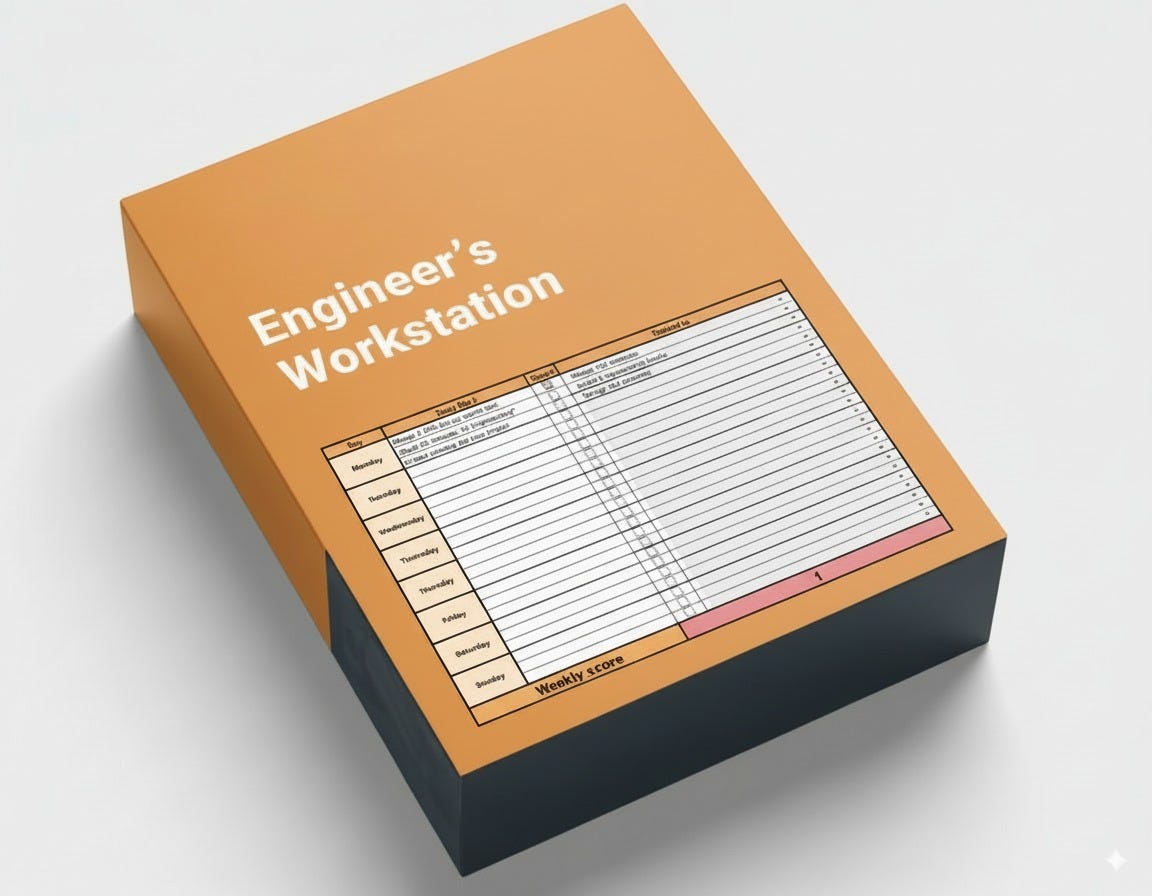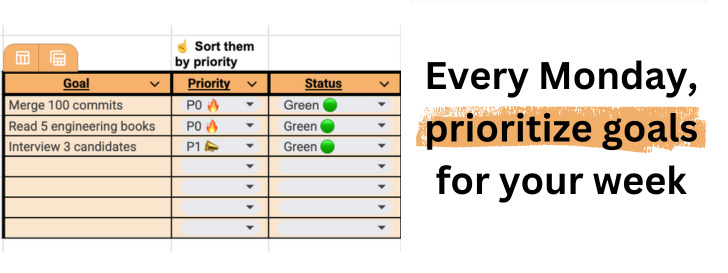This 5-minute daily habit made me a productive software engineer in Big Tech
For the software engineer who feels busy but not productive: here is the 5-minute daily routine I used at Amazon to make a huge impact. This isn't just theory, but a ready-to-use system.
Hi everyone!
I’m excited to share that StrategizeYourCareer has passed 20,000 subscribers. The newsletter’s second birthday is coming up at the end of September, which makes it the perfect time to revisit the roadmap and direction, especially for paid subscribers. I’ve also changed how the newsletter looks. Let me know what you think!
I’ll share more updates in a separate post. Today, I’ve written what I believe is the most impactful article in the newsletter. We only reach our goals if we do two things: 1) define them clearly, and 2) take daily steps toward them.
In this article, I share the system I personally use. Paid subscribers can download it and start applying it right away.
I hope you enjoy it!
I was shipping features, but I was feeling stagnant. Sounds similar?
The difference between a good engineer and a top-tier engineer isn't just coding skill. It's the ability to operate with intention.
Most engineers operate on a single timescale: the current sprint. This leads to career stagnation, burnout, and watching others get promoted.
Multi-scale planning is the antidote. It’s a framework to connect your daily actions to your long-term goals. The system, popularized by Cal Newport, forces you to operate at multiple time horizons: daily, weekly, quarterly, and yearly. Each line of code you write moves you one step closer to your five-year vision.
I’ve created a workstation for you to use every day:
⭐ In this post, you'll learn
How to escape the reactive cycle of tickets and distractions
How to define clear career goals and plan against them
How to grow without burning out or working longer hours
The day
The day is your unit of execution. Win the day, and the week takes care of itself.
If you start every morning reacting to Slack and context switching across tickets, you’ve already lost. The goal is to start each day with clarity and end it with intention.
Plan
My morning starts with defining the "Big 3": the three things that matter most. I do this before checking Slack or email. These tasks align with my longer-term goals. If I complete only those three, I still win the day.
The first deep work block of the day is sacred. I defend my maker time aggressively. I remember feeling fulfilled after dedicating just a 45-minute block on a design doc before the daily chaos began. Dedicating just one hour isn’t enough to fall behind on PRs or unread messages. And you get progress in your most important task
Time-blocking is non-negotiable. Every 15-minute block has a job. If the calendar says “PR reviews,” I’m not jumping into reading something else. I can do this in 15 minutes. The purpose isn’t to be too rigid, but to reduce decision fatigue. I use a calendar app for this.
Execute
For any system to work, you have to follow it. There’s no point in planning if you don’t do the tasks. Energy is variable, so I don’t plan my entire day in advance. I’m planning 1-2 hours ahead, and only planning further ahead for appointments and meetings.
The key for me is to choose consciously, not default to easy distractions. Something I started doing was to batch PRs in the morning after the focus block. It unblocks others and allows me not to be late on reviews for the entire next day.
Reflect
My day ends with a five-minute shutdown ritual. I write down the next steps for the tasks I have open. This helps me disconnect from work until the next morning.
I haven’t included daily reflection in the template because I don’t think it’s something you have the time to do every day. If you are hardcode about journaling like I am, you can write anecdotes of the day and categorize them as highlights or lowlights.
Why did this go well/badly and why?
What frustrated me, and how can I avoid it?
After a few days, you’ll start to see patterns. One day, I realized I was just doing things. The reflection made it clear: I needed to execute against a plan, not a simple reaction to noise.
The week
The week is your unit of progress. If your days are the building blocks, the week is the blueprint. This is where you ensure you’re working on the right things, not just working more.
Plan
Every Monday, I review my quarterly goals. This helps me avoid the common trap of chasing low-leverage work. Then, I define 2–3 key workstreams. These are not simple tasks; they're substantial projects with multiple steps.
Recently, I led a new service launch. I split it into three streams: building the API, handling async events, and writing a data processing algorithm. The clarity was immediate, and this allowed multiple team members to work in parallel, so I had to put a goal only about one of the workstreams myself..
This also allows for scanning for bottlenecks. One Monday, I reviewed our launch timeline and saw a risk. I flagged dependencies and booked time with my manager. We resolved it before it became a crisis. Waiting would have cost us a week.
Execute
Execution during the week is about staying connected to the workstreams you committed to. I start each day by checking the list of goals I prioritized on Monday.. If I’m falling behind on one stream, I course-correct immediately. This keeps my week outcome-driven instead of reactive.
I also communicate proactively. If I hit a blocker mid-week, I don’t wait for the next standup to surface it. I reach out, get input, and move forward. This habit keeps the momentum high.
Reflect
Friday is reflection time. I ask one simple question: Did I move my workstreams forward? I use the Plus / Minus / Next format.
Plus: what worked?
Minus: what didn’t?
Next: What will I do differently next week?
Finally, I close open loops. Check my email inbox for any emails I’ve missed. Check my calendar to analyze where I’m spending too much or too little time. Clean desktop.
It sounds small, but ending the week clean lets me start the next one sharp.
The quarter
The quarter is your unit of strategic change. This is where you define the moves that actually change your trajectory. Promotions, scope increases, visibility—they all start here.
Plan
Every quarter, I dedicate half a day to plan (I don’t only plan work with this template, but my entire life).
I start by revisiting my yearly intention.
Then I do a role gap analysis (let me know if you want a template for it). What does the next level require? I take the job description and mark each skill as Red, Amber, or Green.
One quarter, after checking which goals I had completed, I realized I was Green on technical writing but Red on solving complex problems. That became my main focus for the next 90 days. I defined my quarter goals around it.
Then, I align with my manager. Once, I asked my manager directly, “What does a working-backward plan to a Senior Engineer at Amazon look like?” He gave me three areas: internal influence, external influence, and technical complexity.
That conversation shaped my quarter.
Execute
Execution during the quarter is about keeping your objectives visible and active. I review my goals weekly to ensure I’m moving each one forward. If something slips, I reallocate time or escalate the issue.
Reflect
At the end of the quarter, I review my performance data. Feedback, projects, code stats.
I check for progress for my yearly theme, and I define the next goals that make progress towards it.
I also share progress. At Amazon, the performance cycles are 6 months each. But I prepare the quarters ahead of time so I can share updates with my manager and create accountability. This also opens doors to stretch work and clarifies the scope.
The year
Your career exists inside your life, not the other way around. A yearly vision keeps you from overinvesting in work while neglecting everything else that makes life fulfilling.
Plan
Once a year, I take a full week to reflect.
I look at my current life stage. Am I in a “Climb the career ladder” stage? A “Grow Relationships” stage? That framing helps me set realistic expectations across the board. Not every year is for massive career leaps, and that’s fine.
Regardless of the life stage I’m at, I always set some objectives for work. I choose one main theme and some subthemes, so I can always make progress if the main one is blocked temporarily.
Execute
I use my yearly theme area to guide decisions throughout the year. If a new opportunity shows up, I ask: Does this align with the year’s theme? If not, I try to find a way to align it or ask for a different opportunity..
Execution here looks like habits, boundaries, and periodic check-ins.
Reflect
At year’s end, I review my journey. Did I make real progress in my yearly theme? Were there any surprise wins elsewhere?
The progress in your yearly intention shouldn’t come as a surprise. That’s why you keep reviewing your progress each week and quarter.
This yearly reflection is the macro feedback loop. You may not notice day-to-day the progress in your life, but if you’ve done this exercise for a few years, the results are there.
Last January, I wrote an article about yearly reviews, not only for work but for your entire life. Premium subscribers have access to the full article below:
Conclusion
Your yearly vision sets the destination. Your quarterly goals map the route. Your weekly plans steer the ship. Your daily execution fuels the motion. Each level feeds the next.
But the real magic is in following through. This isn’t about perfect plans. It’s about feedback loops. Daily, weekly, quarterly, yearly. That’s what lets you adapt and course-correct faster than anyone else around you.
Stop being a passenger in your career. You have the steering wheel. Start driving.
The productivity workstation template and user guide is available below for paid subscribers:











